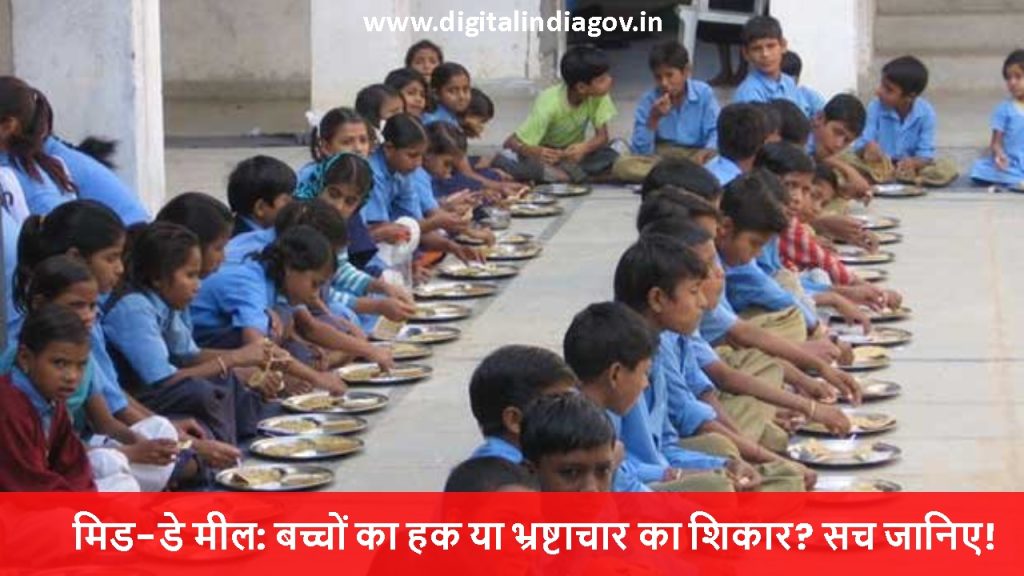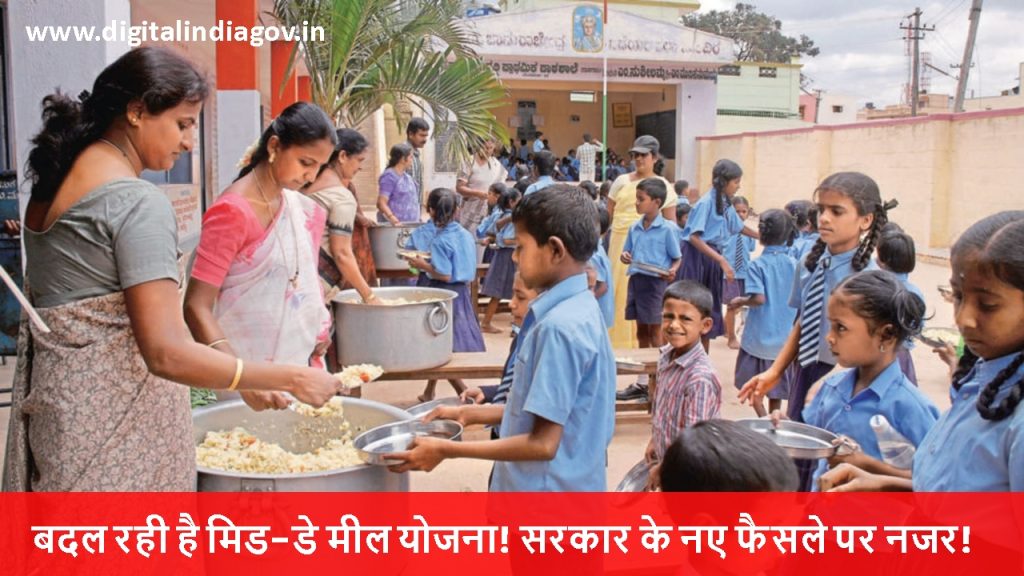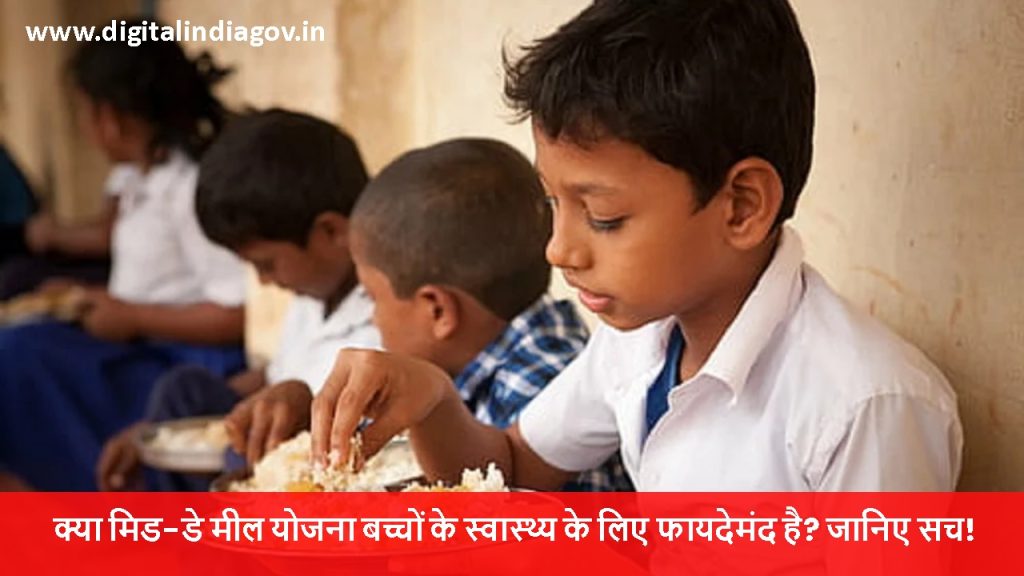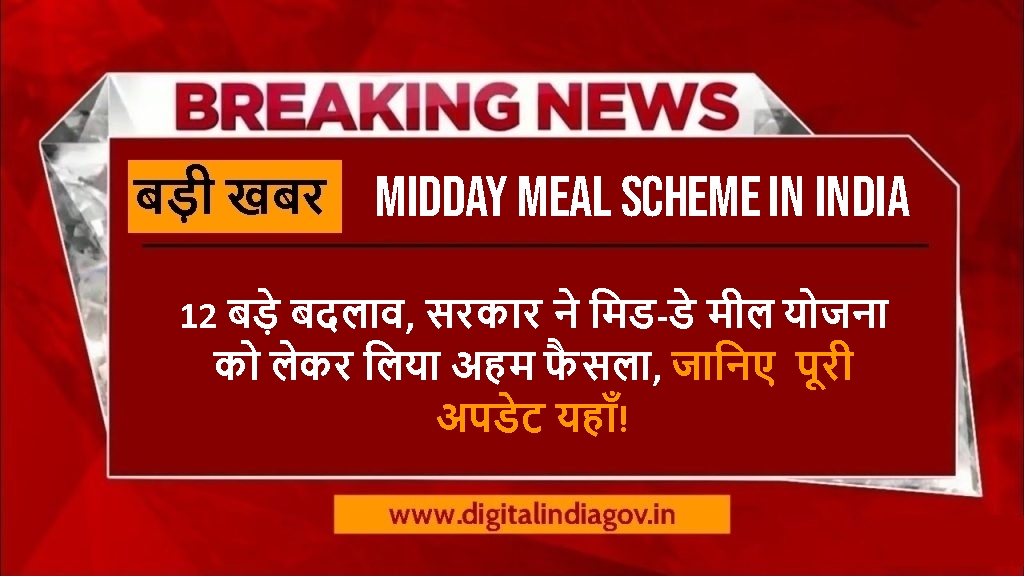Midday Meal Scheme in India, दुनिया के सबसे बड़े स्कूल लंच कार्यक्रमों में से एक भारत की मध्याह्न भोजन योजना (MDMS) है। इसे स्कूल में नामांकन, उपस्थिति और प्रतिधारण दर को बढ़ाने के साथ-साथ स्कूल में नामांकित बच्चों की पोषण गुणवत्ता को बढ़ाने के लिए शुरू किया गया था। इस कार्यक्रम ने बच्चों के समग्र विकास में उल्लेखनीय सुधार किया है, खासकर निम्न आय वाले परिवारों के बच्चों के लिए। भारत की मध्याह्न भोजन योजना का इतिहास, लक्ष्य, कार्यान्वयन, कठिनाइयाँ और प्रभाव सभी इस लेख में शामिल किए जाएँगे।
Contents
History of the Midday Meal Scheme(मध्याह्न भोजन योजना का इतिहास)
The idea of serving food in schools has existed since before independence. The Madras Presidency took the first step in 1925 when it implemented a free school lunch program for underprivileged kids. The Indian government made major efforts to introduce the Midday Meal Scheme across the country after independence.
In 1962–1963, the federal government provided financing to expand the program to other states. Introduced in 1995, the National Programme of Nutritional Support to Primary Education (NP-NSPE) is a centrally financed program that targets pupils enrolled in government and government-aided schools. The program has changed many times throughout the years to increase its effectiveness and reach. To improve children’s nutritional intake, cooked meals were made mandatory in 2001 in response to a Supreme Court order, replacing dry rations.
Also Read: Amrit Dharohar Scheme, yojanaforall.com, Typingspeedtestonline, Onlinereferjobs
Objectives of the Midday Meal Scheme(मध्याह्न भोजन योजना के उद्देश्य)
मध्याह्न भोजन योजना के मुख्य लक्ष्य निम्नलिखित हैं:

- पोषण की स्थिति में सुधार: बच्चों को कुपोषण और एनीमिया तथा विकास अवरुद्धता जैसी संबंधित स्थितियों से लड़ने के लिए पर्याप्त भोजन देना।
- स्कूल में नामांकन और उपस्थिति बढ़ाना: बच्चों को, विशेष रूप से वंचित पृष्ठभूमि से आने वाले बच्चों को, नियमित रूप से स्कूल जाने के लिए प्रेरित करने के लिए, निःशुल्क भोजन उपलब्ध कराना।
- यह सुनिश्चित करना कि सभी बच्चे एक जैसा भोजन करें, विभिन्न सामाजिक और आर्थिक स्तरों के बीच अंतर को पाटकर समावेशन और सामाजिक समानता को बढ़ावा देने में मदद करता है।
- महिलाओं और स्थानीय समुदायों को सशक्त बनाना: सामुदायिक भागीदारी बढ़ाने और रोजगार की संभावनाएँ पैदा करने के लिए, स्थानीय स्वयं सहायता समूह, महिला संगठन और गैर-सरकारी संगठन भोजन की तैयारी और वितरण में शामिल हैं।
- संज्ञानात्मक विकास में सुधार: स्वस्थ भोजन बच्चों को कक्षा में बेहतर ध्यान केंद्रित करने और उनकी संज्ञानात्मक क्षमताओं को बढ़ाकर अकादमिक रूप से बेहतर प्रदर्शन करने में मदद करता है।
Implementation and Execution(कार्यान्वयन और निष्पादन)
The Midday Meal Scheme is implemented through a collaborative effort involving the central government, state governments, and local authorities. The major aspects of implementation include:
Funding and Financial Support
The scheme is jointly funded by the central and state governments. The central government provides financial assistance for food grains, cooking costs, infrastructure, and monitoring, while the state governments contribute additional funds and oversee execution.
Food Preparation and Quality Control
Meals are prepared in school kitchens or by NGOs and self-help groups under strict hygiene and quality control measures. Many states have partnered with organizations like the Akshaya Patra Foundation to ensure high-quality meal preparation in centralized kitchens.
Menu and Nutritional Guidelines
The meals must be nutritious and contain essential nutrients like protein, carbohydrates, vitamins, and minerals. The menu varies by state and region, taking into account local food habits and dietary preferences. It typically includes rice, chapati, pulses, vegetables, and dairy products.
Supervision and Monitoring
Regular inspections are conducted by government officials and school authorities to ensure proper implementation. Additionally, a grievance redressal mechanism is in place to report any issues related to food quality, hygiene, or corruption.
Nutritional Benefits of the Midday Meal Scheme(मध्याह्न भोजन योजना के पोषण संबंधी लाभ)
मध्याह्न भोजन योजना से बच्चों के पोषण संबंधी स्वास्थ्य को बहुत लाभ हुआ है। कार्यक्रम के तहत दिए जाने वाले भोजन में महत्वपूर्ण पोषक तत्व होते हैं जैसे:
- कार्बोहाइड्रेट: लंबे समय तक ऊर्जा के लिए गेहूं, चावल या बाजरा।
- प्रोटीन: मांसपेशियों के विकास और वृद्धि में सहायता के लिए अंडे, बीन्स और दालें।
- विटामिन और खनिज: फलों और सब्जियों में पाए जाने वाले आवश्यक सूक्ष्म पोषक तत्व।
- डेयरी उत्पाद: कैल्शियम के सेवन को पूरक करके स्वस्थ हड्डियों को बनाए रखने में मदद करने के लिए दूध और दही।
- आयरन, आयोडीन और विटामिन ए-फोर्टिफाइड चावल और नमक ऐसे खाद्य पदार्थों के उदाहरण हैं जो एनीमिया और गण्डमाला जैसी कमियों से बचने में मदद करते हैं।
Role of NGOs and Private Organizations(गैर सरकारी संगठनों और निजी संगठनों की भूमिका)

A number of private and non-governmental groups actively participate in the Midday Meal Scheme’s implementation. By giving millions of children nutritious, sanitary meals, organizations like the Akshaya Patra Foundation and ISKCON Food Relief Foundation have made a substantial contribution. Their participation guarantees improved infrastructure, effective meal distribution, and quality monitoring. These groups run centralized kitchens that prepare meals in large quantities and use specialized logistics networks to deliver them to schools.
Also Read: PMUY Scheme, ssorajasthanidlogin.com, shaladarpanportalgov.com
Challenges in the Implementation of the Midday Meal Scheme(मध्याह्न भोजन योजना के कार्यान्वयन में चुनौतियाँ)
मध्याह्न भोजन योजना अपनी सफलता के बावजूद अभी भी कई बाधाओं का सामना कर रही है:
- भोजन की गुणवत्ता और स्वच्छता से जुड़ी समस्याएँ: कभी-कभी भोजन में मिलावट हो जाती है, जिसके परिणामस्वरूप बच्चों में भोजन विषाक्तता हो जाती है।
- भ्रष्टाचार और खराब प्रबंधन: कुछ क्षेत्रों में, भ्रष्ट अधिकारियों को वित्त और खाद्य आपूर्ति को गलत दिशा में मोड़ने के लिए जाना जाता है।
- बुनियादी ढाँचे की कमी: बहुत से स्कूलों में भोजन भंडारण, स्वच्छ पेयजल और उपयुक्त खाना पकाने की सुविधाओं के लिए पर्याप्त जगह नहीं है।
- भोजन आपूर्ति में अनियमितताएँ: भोजन आपूर्ति श्रृंखलाओं में देरी या अनियमितताओं के कारण दैनिक भोजन की उपलब्धता प्रभावित होती है, जिससे स्कूल में उपस्थिति में व्यवधान हो सकता है।
- सामाजिक भेदभाव: जाति-आधारित भेदभाव के मामलों में विशेष समुदायों के बच्चों को सामुदायिक भोजन व्यवस्था से बाहर रखा गया है।
Success Stories and Positive Impact(सफलता की कहानियाँ और सकारात्मक प्रभाव)
Indian society has changed dramatically as a result of the Midday Meal Scheme. Among the noteworthy success stories are:
- Higher Enrollment Rates: Because free meals are available, more kids—particularly girls—are routinely attending school.
- Better Academic Performance: Increased cognitive function and academic performance are results of improved nutrition.
- Economic Benefits for Women: Women’s livelihoods have improved as a result of employment opportunities in meal preparation and delivery.
- Decrease in Child Malnutrition: Research indicates that school-age children are experiencing a decrease in malnutrition rates.
Government Reforms and Future Prospects(सरकारी सुधार और भविष्य की संभावनाएं)
भारत सरकार ने मध्याह्न भोजन योजना की प्रभावकारिता बढ़ाने के लिए कई पहलों को लागू किया है:
- कुपोषण से लड़ने के लिए फोर्टिफाइड चावल की शुरुआत की गई।
- कार्यान्वयन प्रक्रिया को डिजिटल बनाने और उस पर नज़र रखने के लिए सिस्टम।
- बेहतर सामुदायिक भागीदारी के लिए जागरूकता बढ़ाने की पहल।
- बुनियादी ढांचे के विकास और बेहतर खाद्य गुणवत्ता के लिए अधिक धन।
Future Recommendations(भविष्य की सिफारिशें)
Future improvements to the plan could include:
- Increasing Coverage: Adding pupils in pre-primary and secondary education to the program.
- Technology Integration: Transparent fund administration and monitoring through the use of digital platforms.
- Improving Nutritional Standards: Consistent meal menu revisions grounded in scientific advice.
- Public-Private Partnerships: Promoting business participation to improve finance and implementation.
- Training for Cook Staff: To preserve food quality, cooks should participate in safety and hygiene training programs.

Also Read: SBI MIS Scheme, Digitizeindiagovin.com, Nebsit Council, Mobilenumbertrackeronline
Conclusion
In India, the Midday Meal Scheme is an important program that aims to improve social fairness, education, and child nutrition. Despite ongoing difficulties, the plan is still developing thanks to revisions and creative ideas. India’s objectives of universal education and improved public health can be greatly aided by a well-executed midday meal program. The future success of this program will be greatly dependent on ongoing government backing, community involvement, and technology developments.
Faq’s
Q. The Midday Meal Scheme is available to whom?
Ans: Students in government and government-aided basic and upper primary schools throughout India are eligible for the program.
Q. What kind of food does the Midday Meal Scheme offer?
Ans: Rice, chapati, grains, veggies, and dairy items are usually included in the meals. Additionally, several states offer fortified foods and eggs.
Q. The Midday Meal Scheme is funded by whom?
Ans: Both the federal and state governments contribute to the program’s funding.
Q. What nutritional advantages does the program offer?
Ans: By supplying vital nutrients like proteins, carbs, vitamins, and minerals, it aids in the fight against malnutrition.
Q. Does the scheme’s implementation involve any NGOs?
Ans: Indeed, several NGOs, such as the Akshaya Patra Foundation, assist in effectively preparing and distributing meals.
@PAY
